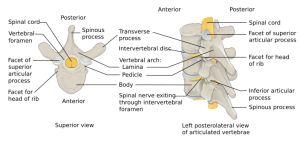Cervical fractures and dislocations: Difference between revisions
No edit summary |
|||
| Line 1: | Line 1: | ||
{{Adult top}} [[cervical injury (peds)]] | {{Adult top}} [[cervical injury (peds)]] | ||
==Background== | ==Background== | ||
[[File:Grant 1962 664.png|thumb|Sensation of cervical nerve roots]] | [[File:Grant 1962 664.png|thumb|Sensation of cervical nerve roots]] | ||
[[File:Three-column-concept-2.jpg|thumb|Three column concept of spinal fracture stability]] | [[File:Three-column-concept-2.jpg|thumb|Three column concept of spinal fracture stability]] | ||
Revision as of 14:15, 22 February 2020
This page is for adult patients. For pediatric patients, see: cervical injury (peds)
Background
Vertebral fractures and dislocations types
- Cervical fractures and dislocations
- Thoracic and lumbar fractures and dislocations
Clinical Features
C-spine injuries may present with
- Rarely neurogenic shock (bradycardia, hypotension)
- Posterior neck pain
- Pain on palpation of spinous processes
- Limited neck ROM with pain
- Weakness, numbness, or paresthesias
Differential Diagnosis
Neck Trauma
- Penetrating neck trauma
- Blunt neck trauma
- Cervical injury
- Neurogenic shock
- Spinal cord injury
Evaluation
Management
- Prehospital
- Hospital
- See page for specific fracture
- Cervical spine clearance
Disposition
See Also
- Cervical spine clearance
- C-Spine (EAST)
- Penetrating neck trauma
- Spinal Cord Trauma
- Spinal Cord Compression (Non-Traumatic)
- Neurogenic Shock
- Unstable spine fractures
- Vertebral fractures
- Cervical injury (peds)
Neck Trauma
- Penetrating neck trauma
- Blunt neck trauma
- Cervical injury
- Neurogenic shock
- Spinal cord injury






